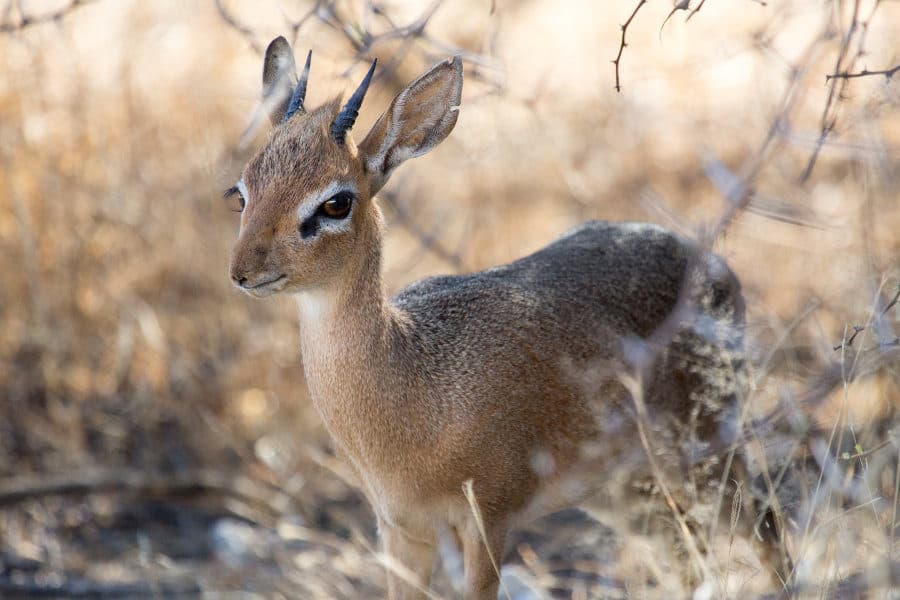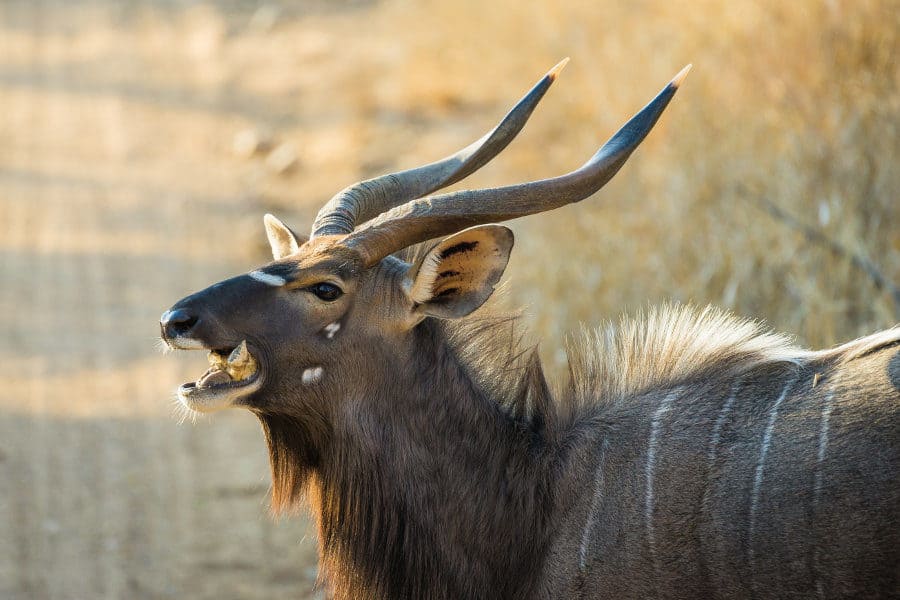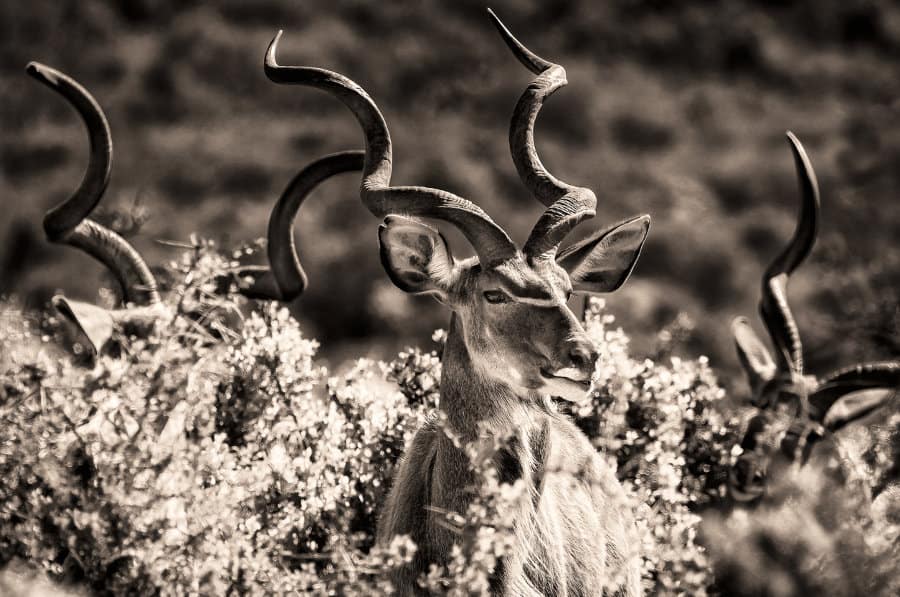Are you wondering ‘what is a dik-dik’?
Well, it is one of Africa’s most unusual antelopes.
Dik-diks are tiny and adorable animals, barely large enough to poke their heads above the grass. They are antelope in the genus Madoqua.
You’ll find them in eastern and southern Africa – if you’re lucky, as these shy creatures are not so easy to come across.
And they’re pretty small, which makes them harder to spot. Yet they do provide one of the cutest encounters you will have on an African safari.
Although they look like antelope, dik-diks are completely different from Africa’s other antelope species. Their name is unusual enough.
In this article, we celebrate these beautiful creatures and highlight some intriguing facts about dik-diks.
African Dik-Dik Facts That Might Surprise You
Dik-dik is the fascinating name given to a few tiny African antelope.
These adorable animals have several quirky traits, from using dung as a form of defense to their charming calls.
Here are a few interesting things to know about the cute dik-dik.
What is a dik-dik’s size and speed?
Mature dik-diks only measure 30-40 cm in height. That’s the length of a standard ruler. During the rainy season, they have to move territories because the grass gets so high they can’t see.
Weighing in at only 2-6 kg, they are not much heavier than a Christmas turkey. You could pick one up with a single hand, except that will not happen because of the incredible dik-dik speed. It can sprint at 40 km/h.
Despite being nowhere close to the largest antelope species in Africa, dik-diks are not actually the smallest. That honor goes to the royal antelope of West Africa, an animal that grows to 25 cm and is nowhere near as cute.
African dik-dik sound & name meaning

The double-barrelled name may seem bizarre at first. It’s actually one of the most logical names in the entire animal kingdom.
Dik-diks are named after the sound they make. This onomatopoeia represents the whistling warning sound of a dik-dik, predominantly made by females.
What does a dik-dik sound like? It is a high-pitched shrill. But, whether it should be translated as “dik-dik” is open to interpretation. Have a listen to this dik-dik noise for yourself.
There are four dik-dik subspecies
While they all make the same call and are undeniably small and cute, there are four subspecies.
Around half a million Günther’s dik-dik live in the shrubs of Kenya, Somalia, and Ethiopia. This species is a grazer and sports a reddish-brown coat.
Kirk’s dik-dik is the most common subspecies and is resident in Tanzania, Kenya, Somalia, Namibia, and Angola.
The IUCN reports that their population could be over 1 million. These dik-diks are desert-adapted and take much of their water directly from vegetation.
Silver dik-diks are the smallest of them all and only weigh 2-3 kg. They occupy southern Ethiopia and Somalia, and their population is unknown.
Salt’s dik-diks are very similar to their silver cousins and live in the desert regions of Ethiopia, Somalia, Kenya, and Eritrea.
Dik-dik antelope don’t live in herds

You’ll find that almost every African antelope bands together in a herd. Larger herds are advantageous as there is safety in numbers. More sentinels can keep guard, and if lions come to attack, they can only eat one out of many.
However, dik-diks are completely different. They live in pairs and are one of the most romantic animals on the planet.
Dik-dik are monogamous and have lifelong partners
As the saying goes, two is company and three is a crowd. Dik-diks are so dedicated to having alone time that they even chase away their offspring.
Mothers are responsible for telling their daughters to leave, and fathers must chase off the males. This happens before the baby dik-dik has reached eight months of age.
Rather than swanning around searching for mates, these tiny antelope are monogamous and stay with a single partner until death do us part.
Some researchers argue that dik-diks choose to be monogamous because of the dangers associated with finding a mate. However, that doesn’t add up.
Many male antelope will fight to the death in the hope of becoming dominant and getting the chance to mate. Maybe dik-diks simply have amorous souls.
For more information on monogamy in animals, check out this article.
There are many dik-dik predators

Dik-diks are so incredibly small that they are an easy meal for a huge variety of predators.
Lions are the only large carnivores that don’t usually hunt them. The king of the savannah needs to consume an average of 35-50 kg of meat per week, so 3 kg of dik-dik meat is hardly even a snack.
Leopards and cheetahs will hunt these tiny antelopes, as will caracals, jackals, wildcats, servals, and hyenas. There is an added threat from the air. Dik-diks are so small that they are a popular food of eagles.
What’s a dik-dik’s breeding habits?
Many African animals have a strict breeding season with mating rights based on size and dominance.
For example, the largest hippo will end up with an entire harem of females. Or a large Cape buffalo will enjoy one season mating with the herd but will then retire to veteran status and never breed again.
Dik-dik can breed continuously, and a pair can time their newborn to coincide with the best conditions in their territory.
Their monogamous relationship is built entirely on trust. One is always on the lookout as the other grazes. Studies show that the larger the herd, the less vigilant the antelope.
Every antelope leaves the lookout duty for everyone else. So when you have no natural defense, it makes sense to stay as a couple.
Dik-dik tears are used to mark their territory

Most animals mark their territories by urinating. This gives off a special scent to ward off rivals. So if you notice your pet dog peeing on objects in the street, it is marking its territory.
In sharp contrast, dik-diks bury their heads into the grass and release a special tear from a black spot below their eyes.
This sticky preorbital glandular fluid cannot be smelled by human nostrils but conveys everything necessary to other dik-diks.
Dik-diks use dung and scents to mark boundaries
Even though they live monogamously, males still need to defend their partners against rivals. Plus, couples need their space, so it’s not uncommon to have territorial border disputes.
It is rare for dik-dik to fight. Instead, they show off by building up sizable heaps of dung.
The higher the dung, the more impressive the couple, so these crafty pairs get a head start by leaving their feces on top of elephant or buffalo dung.
Almost every other African animal just lets go of their bowels wherever they are. Some even do it while they are walking! Dik-diks are toilet-trained and keep their territory clean by depositing their excrement all in one place.
They adapted and evolved for desert environments

Dik-diks occupy arid shrubland and desert areas where there are fewer natural predators. They can survive without water, which is pretty much essential because such a small animal wouldn’t last long at a crowded waterhole.
Instead of waterholes, dik-diks take most of their water from succulents and lush foliage, meaning they extract water directly from their food.
Naturally, they avoid the hottest part of the day. Most of their feeding takes place during the night, and during the hottest months, they will become nocturnal.
A special form of rapid nasal panting means dik-diks breathe without losing moisture through their exhaled air.
These remarkable antelopes can also lower their metabolic rate and adjust their body temperature based on the conditions.
They are abundant antelope that are difficult to find
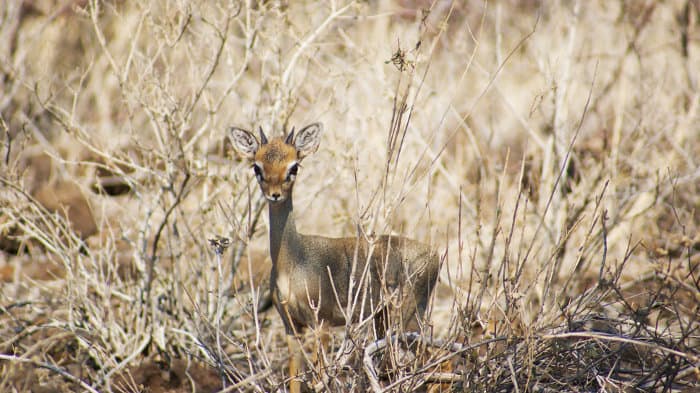
Africa’s other abundant antelope are almost impossible to miss. You can’t visit Tanzania without encountering wildebeest, and it wouldn’t be a Southern Africa safari without springbok.
But even though there are around 1 million dik-diks, they are one of Africa’s rarest sights. Not only are they incredibly small, but their fur coats provide perfect camouflage with dry season vegetation.
They rest through the middle of the day by lying in the grass, concealed from the world.
Still, dik-dik should be on your wish list when going on an African safari. While all the talk is of the famous big five, this remarkable antelope proves small animals can provide just as much enchantment.
Try to Spot an African Dik-Dik on a Safari
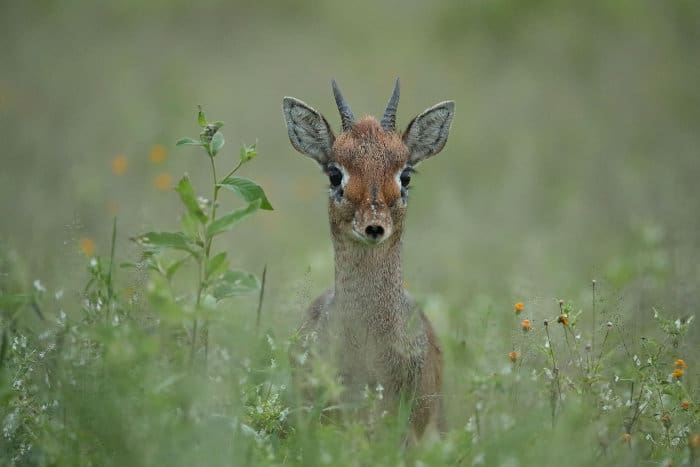
From their fascinating name to their relationship habits, these tiny antelopes express interesting characteristics and behaviours.
So next time someone asks, “what’s a dik-dik”, you can intrigue them with some exciting facts.
Although reading about such cute little creatures is rather captivating, seeing them in their natural habitat is a spectacular experience.
Check out the following safari deals and book a trip for the best chances to see these elusive animals. And if you’re lucky enough to spot a dik-dik, be sure to snap a shot to capture the delightful encounter.
